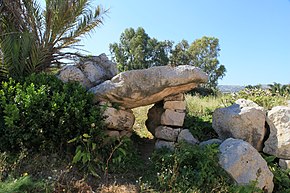Tal-Qadi Temple

Ruins at Tal-Qadi
|
|
| Location | Salina, Malta |
|---|---|
| Coordinates | 35°56′11.96″N 14°25′13.74″E / 35.9366556°N 14.4204833°E |
| Type | Temple |
| Part of | Megalithic Temples of Malta |
| History | |
| Material | Limestone |
| Founded | c.4000 BC (earliest remains) c.3300–3000 BC (temple) |
| Periods |
Tarxien phase Tarxien Cemetery phase |
| Site notes | |
| Excavation dates | 1927–1952 |
| Archaeologists |
L. Upton Way |
| Condition | Poorly preserved ruins |
| Ownership | Government of Malta |
| Public access | Yes |
Tal-Qadi Temple is a megalithic temple in Salina, limits of Naxxar, Malta. It is in a very bad state of preservation, with only the temple's general outline still visible.
The site of Tal-Qadi was possibly in use around 4000 BC, during the Ġgantija phase of Maltese prehistory, but the temple itself was built during the Tarxien phase between 3300 and 3000 BC. The temple continued to be used during the Tarxien Cemetery phase, since pottery sherds from that era have been found.
Tal-Qadi is the only temple in Malta which is orientated to the north-east. Most other temples face the south or south-east, but in the case of Tal-Qadi this would not have been possible since there is a steep slope in that direction.
Today, the temple is in poor condition, with few remains visible apart from its general outline. The remains of a central area and two apses can still be seen. The temple probably contained another two apses, giving it a four-apse shape which was typical of the late temple period. No traces of the temple's façade exist.
The scattered remains of the temple, spread out on an upper and a lower field, were discovered by Henry Sant, a government civil engineer, in 1916. The area was excavated in 1927 by and L. Upton Way. According to Zammit, years before the identification of the temple, the tenant of the site had destroyed a group of upright stones. These might have been the remains of the temple's missing façade or its outer casing.
During the excavations, a broken globigerina limestone slab showing five sections separated by lines, and incised with star-like figures and a crescent shape in the middle (possibly representing the moon) was found. This slab possibly was a star map or a moon calendar. It is now located in the National Museum of Archaeology in Valletta.
The remains of the temple were surveyed and mapped in 1952.
...
Wikipedia
